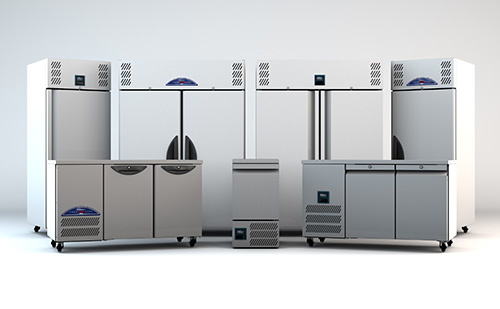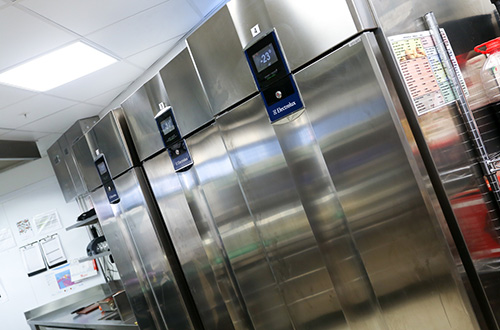Cold facts: what new EU refrigeration laws mean for your business
New EU legislation has led to things hotting up in the world of refrigeration. Lisa Jenkins examines the implications, costs and potential long-term benefits
Regardless of the fact that the UK has voted to leave the EU, manufacturers of refrigeration equipment being sold into Europe must comply with the new Minimum Equipment Performance Standards (MEPS).
The new Ecodesign and Energy Labelling legislation, which came into effect on 1 July, uses a new test standard (EN16825) and requires manufacturers of professional refrigerated storage cabinets, solid door cabinets and solid counter-top refrigeration units to adhere to the MEPS and to display the results of the test standards on all equipment using a colour-coded system.
The coloured labelling shows products graded from A to G, or from A+++ to G, where A (or A+++) is best and all refrigerated equipment included in the new legislation must have at least a G label to be sold within Europe.
Glenn Roberts, managing director at Hoshizaki Gram UK, says: "Even though we are moving out of Europe, nothing has changed. If you are a refrigeration manufacturer in the UK who exports to Europe and you want to continue selling into Europe, you will have to conform to this legislation. Every other supplier who is buying refrigeration equipment from Europe and selling it in the UK or Europe will also have to conform.
Precision Refrigeration cabinets
How to go green
Alongside the F gas regulations, which came into effect on 1 January 2015 and are designed to control the use of fluorinated greenhouse gases, manufacturers will be doing their best to convert to alternative refrigerants, such as hydrocarbon, which are more efficient and better for the environment.
Manufacturers who find themselves with refrigeration in the G and F categories may decide to simply switch to new refrigerants to improve their products. âBut there is no silver bullet to saving energy,â says Roberts.
âItâs like cycling hero Dave Brailsford said,â adds Roberts, âif it was possible to make a 1% improvement in a whole host of areas, the cumulative gains would end up being hugely significant.â
The new test is weighted, and the final energy index (label) you get is a representation of the kilowatts consumed during that test process compared to its net useable volume.
Net useable volume is a sticking point too â" the more useable space inside the refrigeration, the easier it is to improve your score. So businesses will see a footprint change when buying cabinets in the future, as they may get bigger. This will impact commercial kitchens with already limited space.
Williams Refrigeration range
Test conditions
The MEPS tests have to be performed in a controlled environment â" at 32°C and 55% relative humidity. It takes half a day to prepare the room to a settled temperature and a couple of cycles for optimisation. The tests have to be witnessed if performed on a manufacturerâs own premises and carried out in an approved test chamber. It costs £3,500 per cabinet and if a manufacturer does not have their own test chamber, outsourced facilities are required at an extra cost.
Hoshizaki Gram UK tested 121 products as of 1 July â" which equates to £423,500 â" and the company hasnât finished yet.
Jon Usher, head of UK sales and marketing at Lec Commercial, says: âRefrigeration provides an essential role in every kitchen, whether front or back of house. When purchasing a new refrigeration appliance, thought should be given not just to the size and features, but also to the energy efficiency. The simple, easy-to-read, colour-coded guide takes elements of the consumer energy labelling that has been in place for many years and applies it to commercial equipment.â
Nick Williams, managing director of Precision Refrigeration, says: âThe new labelling gives buyers the opportunity to compare different models of refrigeration for energy usage. This is important as refrigeration operates 24/7 and has to be factored in any commercial catering operation looking to cut costs.
âManufacturers have had their work cut out improving and testing their models in a limited timeframe, so little has been done to educate operators, dealers or distributors.
âHowever, these changes can only benefit them as energy cost and total cost of ownership become more important. After all, energy costs are only going to increase, so energy efficient equipment will become more and more important over time,â adds Williams.
Adande A+ VCR2
Adande Refrigeration has responded to the new legislation by launching its A+ Fridge, which ranges from 0°C to +15°C. Adande is perhaps better known for its refrigerated drawer units that operate within a fridge to freezer range of -22°C to +15°C, âbut there are still customers who would prefer a ârefrigeration onlyâ option,â says Karl Hodgson, UK sales director. âOur A+ Fridge will achieve savings and meet waste reduction, sustainability and corporate responsibility targets.â
For Stuart Flint, training and demonstration manager at Electrolux Professional, the whole-life cost of the equipment is something to be taken seriously when buying new kit. âThe adage, âbuy once, buy wellâ certainly comes into play when we look at refrigeration equipment, as there can be differences in quality between various suppliers and brands,â he says.
âTo an extent, fridges can be expected to last many years with minimal maintenance. This means buying higher grade equipment with top-of-the-range efficiency and performance criteria has the potential to avoid unnecessary repair costs over the long term, â adds Flint
Electroluxâs latest generation of refrigeration equipment, ecostore HP, is fully compliant with classification A on the new label and optimised for maximum storage capacity.
Tim Keating, managing director and owner of Pico Catering Projects and a Cedabond member, says the new legislation will allow fair comparisons of products across the market. He says: âAlthough in reality most buyers already have a clear understanding of energy, this will help less specialist consumers determine energy usage in a clear and concise manner. But buyers should consider this scheme as just one of a range of criteria in their buying decision â" the most important being that their choice meets their operational needs.
âInvesting in energy efficient refrigeration is obviously important,â adds Keating. âHowever, buyers should consider if these efficiency levels can remain at a constant rate in a hot, demanding kitchen over the life span of a product â" which can be 10 years or more.â
Duty calls
Itâs a valid point. The new energy labelling also includes a box relating to the temperature class of the equipment. The box with the house icon will either show a score of three (for use at 25°C/60% relative humidity (RH) and determined âLight Dutyâ), four (for use at 30°C/55% RH and determined âNormal Dutyâ) and five (for use at 40°C/40% RH and determined as âHeavy Dutyâ).
Distributors and dealers should be asking their customers what their envioronment is. The most common is likely to be normal duty or a âfourâ temperature class, which would be typical for a working professional kitchen.
âBuyers should now factor the temperature class into their buying decision, alongside the energy label, lifetime cost, warranty and service package offered,â says Paul Anderson, commercial director for Hoshizaki Gram UK.
The cold truth
âAs we move forward, the EU Ecodesign directive should be viewed as a positive step as the industry continues to reduce its overall carbon footprint,â says Roberts. âHowever, the expectations on refrigeration energy efficiency ratings will increase as businesses start to become more aware of their environmental impact and the cost of utility bills that continue to rise and as energy efficiency moves up the list of priorities on purchasersâ shopping lists.â
As the industry works towards a more sustainable future, manufacturers like Foster Refrigerator, Williams, Precision, Electrolux, Hoshizaki Gram UK and Adande, and distributors and wholesalers (with no control over the manufacture), such as Nisbets, Bidvest Catering Equipment, Interlevin and Pentland, must display the new energy labels on refrigerated storage cabinets to adhere to the MEPS.
Some manufacturers will focus on improving their facilities, while others will lead the way in sustainability and product design. For Simon Frost, chair of the Catering Equipment Suppliers Association: âThe new directives are important for any catering equipment buyer or specifier. They will make it possible to accurately compare running and overall lifetime costs of different models.â
So whatâs next? Work has already started on refrigeration categories currently excluded, as well as on warewashers and ovens, but for now no timelines have been decided.
Gram range
Whatâs on the label
- The A to G rating
- The supplierâs name
- The product/model designation
- Whether itâs a fridge or freezer
- The temperature range
- The tested and approved energy class
- The net volume of the unit
- The annual energy consumption in kWh
- The temperature class
Electrolux Professional
The terminology explained
The Ecodesign Directive
The Ecodesign Directive is specifically about energy saving. Its objective is to help foodservice operators reduce energy consumption by ensuring manufacturers develop more energy-efficient products.
Refrigeration is the first category of equipment to be subject to this legislation.
Escalator
This is the term used to cover the planned upgrades in energy efficiency standards. It is anticipated that over the years manufacturers will continue to develop more energy efficient models. As they do so, the energy labels will change to reflect this â" As will be downgraded to Bs and Gs will fall off the list.
Checks and balances
In the future there will be independent spot checks by the National Regulation and Measurement Office to ensure that the ratings manufacturers provide are accurate.
False energy labelling can also be reported to the Catering Equipment Suppliers Association (CESA).
How will the operator benefit?
- Saving money on lifetime cost
- The product shouldnât break down as much
- Better equipment, better temperature stability
- Equipment with longer warranties as equipment gets better
- Total cost of ownership improves
Lec Commercial Saladette
Suppliers
Adande www.adande.com
Bidvest Catering Equipment www.bidvestcateringequipment.com
CaterOps www.caterops.co.uk
Cedabond www.cedabond.co.uk
CESA www.cesa.org.uk
Electrolux www.professional.electrolux.co.uk/Solutions/Refrigeration
Foster Refrigerator www.fosterrefrigerator.co.uk/ecodesign.asp
Hoshizaki Gram UK gram-commercial.com//gb/en-gb
Interlevin www.interlevin.co.uk
LEC Commercial www.lec-commercial.co.uk
Pentland www.pentlandwholesale.co.uk
Precision www.precision-refrigeration.co.uk
Williams www.williams-refrigeration.co.uk
Â
Â
Â
Â
Â
Â
Â
Â
Â
Â
Â



























